 W
WThe Advanced Arresting Gear (AAG) is a type of arresting gear currently in development by General Atomics for the U.S. Navy's newest Gerald R. Ford-class aircraft carriers.
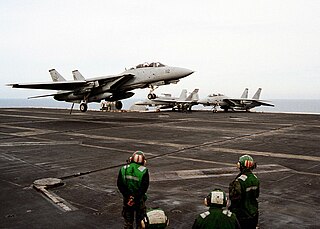 W
WAn arresting gear, or arrestor gear, is a mechanical system used to rapidly decelerate an aircraft as it lands. Arresting gear on aircraft carriers is an essential component of naval aviation, and it is most commonly used on CATOBAR and STOBAR aircraft carriers. Similar systems are also found at land-based airfields for expeditionary or emergency use. Typical systems consist of several steel wire ropes laid across the aircraft landing area, designed to be caught by an aircraft's tailhook. During a normal arrestment, the tailhook engages the wire and the aircraft's kinetic energy is transferred to hydraulic damping systems attached below the carrier deck. There are other related systems which use nets to catch aircraft wings or landing gear. These barricade and barrier systems are only used for emergency arrestments for aircraft without operable tailhooks.
 W
WAn aircraft catapult is an external device used to allow aircraft to take off from a very limited amount of space, such as the deck of a vessel, but also installed land-based runways in rare cases. It is now most commonly used on aircraft carriers, as a form of assisted take off. In the form used on aircraft carriers the catapult consists of a track, or slot, built into the flight deck, below which is a large piston or shuttle that is attached through the track to the nose gear of the aircraft, or in some cases a wire rope, called a catapult bridle, is attached to the aircraft and the catapult shuttle. Other forms have been used historically, such as mounting a launching cart holding a seaplane on a long girder-built structure mounted on the deck of a warship or merchant vessel, but most catapults share a similar sliding track concept. Different means have been used to propel the catapult, such as weight and derrick, gunpowder, flywheel, air pressure, hydraulic, and steam power, and solid fuel rocket boosters. The U.S. Navy is developing the use of Electromagnetic Aircraft Launch Systems with the construction of the Gerald R. Ford-class aircraft carriers. On a modern carrier catapulted aircraft land like conventional aircraft, sometimes with the help of arresting gear when landing on deck. Historically it was most common for seaplanes to be catapulted, allowing them to land on the water near the vessel and be hoisted on board, although in WWII conventional fighter planes would sometimes be catapulted from "catapult-equipped merchant" (CAM) vessels to drive off enemy aircraft, forcing the pilot to either divert to a land based airstrip, or to jump out by parachute or ditch in the water near the convoy and wait for rescue. Some fighters were even completed without landing gear for this purpose, intended to be emergency single-use disposable fighters to drive off enemy aircraft if they attacked or spotted the convoy.
 W
WCATOBAR is a system used for the launch and recovery of aircraft from the deck of an aircraft carrier. Under this technique, aircraft launch using a catapult-assisted take-off and land on the ship using arrestor wires.
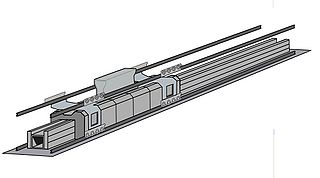 W
WThe Electromagnetic Aircraft Launch System (EMALS) is a type of aircraft launching system developed by General Atomics for the United States Navy. The system launches carrier-based aircraft by means of a catapult employing a linear induction motor rather than the conventional steam piston. EMALS was first installed on the United States Navy's Gerald R. Ford-class aircraft carrier, USS Gerald R. Ford.
 W
WThe flight deck of an aircraft carrier is the surface from which its aircraft take off and land, essentially a miniature airfield at sea. On smaller naval ships which do not have aviation as a primary mission, the landing area for helicopters and other VTOL aircraft is also referred to as the flight deck. The official U.S. Navy term for these vessels is "air-capable ships".
 W
WA folding wing is a wing configuration design feature of aircraft to save space, and is typical of carrier-based aircraft that operate from the limited deck space of aircraft carriers. The folding allows the aircraft to occupy less space in a confined hangar because the folded wing normally rises over the fuselage decreasing the floor area of the aircraft. Vertical clearance is also limited in aircraft carrier hangar decks. In order to accommodate for this, some aircraft such as the Supermarine Seafire and Fairey Gannet have additional hinges to fold the wingtips downward, while others such as the S-3 Viking have folding tails. The F-14 Tomcat's variable-sweep wings could be "overswept" to limit deck space.
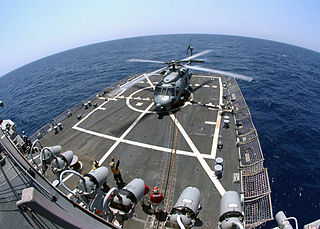 W
WA helicopter deck is a helicopter pad on the deck of a ship, usually located on the stern and always clear of obstacles that would prove hazardous to a helicopter landing. In the United States Navy, it is commonly and properly referred to as the flight deck.
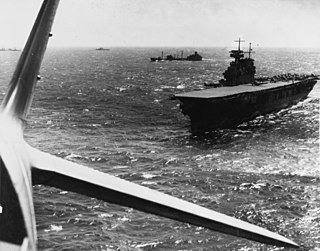 W
WAircraft carrier air operations include a launch and recovery cycle of embarked aircraft. Launch and recovery cycles are scheduled to support efficient use of naval aircraft for searching, defensive patrols, and offensive airstrikes. The relative importance of these three missions varies with time and location. Through the first quarter-century of aircraft carrier operations, launch and recovery cycles attempted to optimize mission performance for ships with a straight flight deck above an aircraft storage hangar deck. Carrier air operations evolved rapidly from experimental ships of the early 1920s through the combat experience of World War II.
 W
WLily and Clover were two experimental floating airfields tested towards the end of the Second World War by the British Admiralty.
 W
WModern United States Navy aircraft carrier air operations include the operation of fixed-wing and rotary aircraft on and around an aircraft carrier for performance of combat or noncombat missions. The flight operations are highly evolved, based on experiences dating back to 1922 with USS Langley.
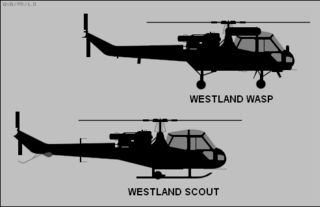 W
WA navalised aircraft is an aircraft that has been specifically designed for naval use, in some cases as a variant of a land-based design. An aircraft based on an aircraft carrier is called carrier-based aircraft.
 W
WAn optical landing system (OLS) is used to give glidepath information to pilots in the terminal phase of landing on an aircraft carrier.
 W
WIn aviation, a ski-jump is an upward-curved ramp that allows aircraft to take off from a runway that is shorter than the aircraft's required takeoff roll. By forcing the aircraft upwards, lift-off can be achieved at a lower airspeed than that required for sustained flight, while allowing the aircraft to accelerate to such speed in the air rather than on the runway. Ski-jumps are commonly used to launch airplanes from aircraft carriers that lack catapults.
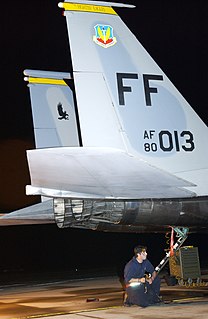 W
WA tailhook, arresting hook, or arrester hook is a device attached to the empennage (rear) of some military fixed-wing aircraft. The hook is used to achieve rapid deceleration during routine landings aboard aircraft carrier flight decks at sea, or during emergency landings or aborted takeoffs at properly equipped airports.